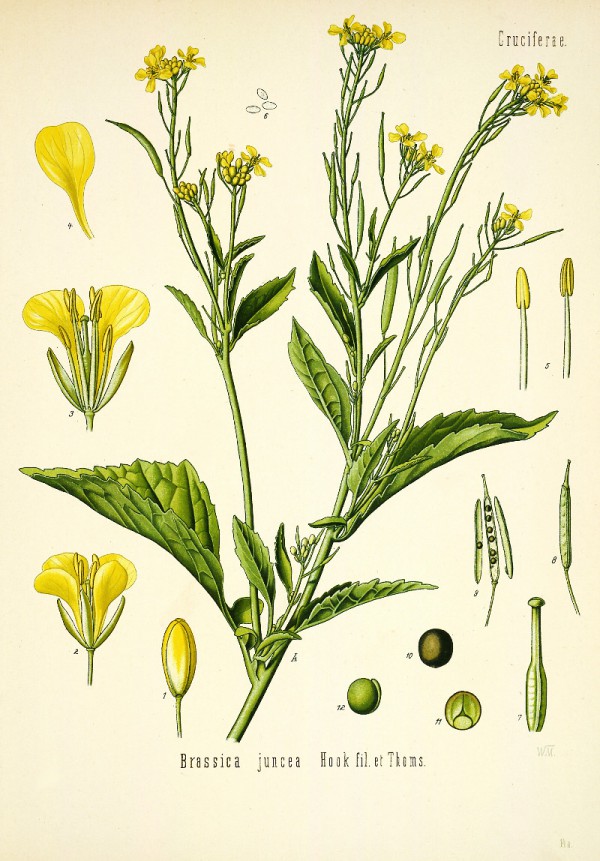Brassica juncea (L.) Czern. - Brassicaceae - brown mustard, Chinese mustard, Indian mustard, leaf mustard, Brauner Senf
Annual herb, up to 1m high, only known in culture; stem ercect, branched above; basal leaves pinnately lobed, lobes 1-3 each side, up to 30cm long, upper ones oblong or lanceolate, reduced in size distally; flowers yellow; seeds brown or yellow, 1-2 mm in diam.
„The species is an allotetraploid derived from hybridization between B. nigra (n = 8) and B. rapa (n = 10). Its center of origin is uncertain but is most likely the Middle East, with possibly independent multiple origins within overlapping ranges of the putative parental taxa (S. I. Warwick and A. Francis 1994).“
http://www.efloras.org/florataxon.aspx?flora_id=1&taxon_id=200009253
„The leaves, the seeds, and the stem of this mustard variety are edible… Cultivars of B. juncea are grown as greens, and for the production of oilseed… The mustard made from the seeds of the B. juncea is called brown mustard. The leaves and seeds are used in many Indian dishes.“ http://en.wikipedia.org/wiki/Brassica_juncea
B. juncea „shows marked variation in external morphology, especially leaf form“ and also has „been reported in the type of volatile oil produced on the hydrolysis of the seed glucoside; three conditions have been described: a) the production of allyl isothiocyanate only [AITC]; b) the production of 3-butenyl (= ‘crotonyl’) isothiocyanate only; c) the production of a mixture of allyl and 3-butenyl isothiocyanates.“
[Volatile Mustard Oils of Brassica juncea Seeds., Hemingway, J.S., Schofield, H.J., Nature, Vol.192, 1961, 993]
„Headspace analysis confirmed that allyl glucosinolate was the major glucosinolate in all genotypes of B. nigra tested; most genotypes also produced 2-phenylethyl-isothiocyanate (ITC). Brassica juncea genotypes produced variable amounts of AITC and other volatiles with antimicrobial activity, including 2-phenylethyl-ITC, benzyl-ITC, and 3-butenyl-ITC.“
[Variation in allyl isothiocyanate production within Brassica species and correlation with fungicidal activity., Olivier, C., Vaughn, S.F., Mizubuti, E.S., Loria, R., Journal of Chemical Ecology, Vol.25(12), 1999, 2687-2701]
Leaf tissues of Brassica juncea were shown to be rich in 2-propenyl-glucosinolate [allyl isothiocyanate, AITC], which is hydrolysed to 2-propenyl-ITC on tissue damage.
[Characterisation of volatile sulphur-containing compounds produced during decomposition of Brassica juncea tissues in soil., Bending, G.D., Lincoln, S.D., Soil Biology and Biochemistry, Vol.31(5), 1999, 695-703]
Potherb mustard pickle is an indigenous Chinese, generally homemade, fermented vegetable product usually cooked with minced meats or other dishes. It is fermented and cured for about 3 weeks before eating but is consumed by some consumers only after 10 days curing due to its attractive flavor. The majority of the sulfur-containing compounds detected in potherb mustard pickles were dimethyl disulfide, dimethyl trisulfide and dimethyl tetrasulphide. Alcohols detected included isoamylalcohol, (Z)-2-penten-1-ol, 1-hexanol
and phenylethanol. Esters absent from fresh potherb mustard but present in the pickles, were 2-phenylethyl acetate, ethyl decanoate, ethyl phenylacetate and ethyl 3-phenylpropionate.
„Five isothiocyanates were detected, which are AITC, butyl 1-isothiocyanate, isobutyl isothiocyanate, 1-isothiocyanato-3-methyl-butane and (2-isothiocyanatoethyl)-benzene, respectively. These compounds, with mustard oil, pungency, hot-like odors, were reported as major components affecting the characteristic flavor of Chinese cabbage…“
[Zhao, Dayun, Jian Tang, and Xiaolin Ding. „Analysis of volatile components during potherb mustard (Brassica juncea, Coss.) pickle fermentation using SPME–GC-MS.“ LWT-Food Science and Technology 40.3 (2007): 439-447]
„A method based on headspace solid-phase microextraction (HS-SPME) has been applied for the analysis of volatile components in fresh potherb mustard and their pickles with different pickling time… From the glucosinolates degradation products enzymatically via aglycone in fresh potherb mustard and their pickles, the result showed that the glucosinolates in potherb mustard contain allyl, butenyl, isobutanyl and phenylethyl groups in the side chain as substituents, which means that the glucosinolates are sinigrin, gluconapin, glucocochlearin and gluconasturtin, respectively. It can be also concluded from the experiments that the glucosinolates with allyl and phenylethyl groups as side chain in potherb mustard are predominant.“
[Analysis of volatile components during potherb mustard (Brassica juncea, Coss.) pickle fermentation using SPME–GC-MS., Zhao, D., Tang, J., Ding, X., LWT-Food Science and Technology, Vol.40(3), 2007, 439-447]

Köhler,F.E., Medizinal Pflanzen, vol.1, t.14a (1887) [W.Müller]
http://plantgenera.org/species.php?id_species=155979


